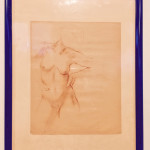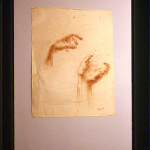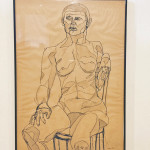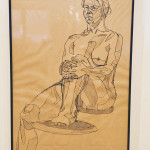-
What if I don’t like a shot?
-
Can I use an alias for attribution to my tattoo shot/s?
-
What if we don’t find any good shots with my tattoo?
-
How do I know if my tattoo is “good enough?”
-
What if my tattoo is a very simple design, with very precise line work and/or letter work and/or shading?
-
Do you keep all the shots on file?
-
Will you make a shit load of profit from my photo?
-
Can my tattoo artist/shop link to your website?
-
What if my tattoo artist is upset about the photo?
-
If you ever get a real art exhibition at some big, fancy gallery or museum, and if I am the subject of one of the photos, will I be invited to the opening?
-
Are you interested in doing shoots of tattoos on or near the “naughty bits”?
-
Are there any celebrities with tattoos who you hope to photgraph someday?
-
Do you, yourself, have tattoos?
-
So what’s the story with the sewing?
-
What is your background in the fine arts?
What if I don’t like a shot?
Shots you dislike will be deleted from my camera, computer and any other devices I use.
Can I use an alias for attribution to my tattoo shot/s?
Absolutely. I understand that for many reasons people may want to keep their tattoos private. I am happy to accommodate this sort of situation.
What if we don’t find any good shots with my tattoo?
In general, there is usually something we’ll get. Part of the process of the shoot necessarily includes positioning and lighting. There’s lots of ways for things to fall into place. In the case that we don’t find anything, I will suggest some options: We can investigate other tattoos you have until we find something great, or I can take your portrait, or, if there has been payment for a session (if that starts to happen) provide a refund for the session deposit.
How do I know if my tattoo is “good enough?”
First thing is that we’ll be photographing a tattoo that you love. These are the tattoos we’re interested in, as a first pass. You should look very hard at your tattoo prior to booking a private session. Tattoos can have enormous emotional value whatever their perceived “quality.” A macro photograph simply cannot capture this dimension of your tattoo in a straightforward way. Focus on the artistry of your tattoo, and then ask yourself if the tattoo is “good enough.” See how you feel.
What if my tattoo is a very simple design, with very precise line work and/or letter work and/or shading?
That’s great! A macro shot of this kind of tattoo may prove very abstract, but that’s a really cool thing.
Do you keep all the shots on file?
No, I do not keep all the shots we take in our session. I keep a portfolio of images selected as acceptable shots, which may be somewhat larger than the final set selected for any publication or exhibition. The rest are deleted.
Will you make a shit load of profit from my photo?
My plan is such that the price of a private session with me may increase with demand, as that would very likely involve travel. In the case that I can find a workable way of doing prints of some shots (not yet an option), some might gain some value in virtue of becoming popular (a seriously long shot, if you ask me). Your name and the name of your tattoo artist will always be attributed to the photo (unless otherwise specified). Art Photography is an expensive endeavor and it’s something I just love to do. Don’t get me started on framing costs. It’s killing me. I’d be overjoyed if the project could pay for itself at some point through some means.
Can my tattoo artist/shop link to your website?
Of course! I’d love to do that.
What if my tattoo artist is upset about the photo?
As an artist, I endeavor to view my photos with an eye for what shots any artist would judge negatively. I take it to be a kind of honor code between artists that I need to uphold. Yet, no doubt aesthetic disagreements arise. My photography focuses on micro-compositions found within the larger composition made by the tattoo artist. These may be radically different than the tattoo artist’s original design. Many shots turn out more abstract than representational. Things that seem cool and artistically interesting to me might turn out cringe-worthy for a tattoo artist. However, I respect a tattoo artist’s disagreement with my point of view, and agree to not post or, if already posted, remove the photo/s in question from exhibition of any kind.
If you ever get a real art exhibition at some big, fancy gallery or museum, and if I am the subject of one of the photos, will I be invited to the opening?
Yes, you and your tattoo artist will be invited. Since we don’t know where in the world such a hypothetical art exhibition might happen, I can’t guarantee that you will actually be able to attend the hypothetical exhibit, but you will be invited to it non-hypothetically in this hypothetical scenario. Wear your best hypothetical stuff.
Are you interested in doing shoots of tattoos on or near the “naughty bits”?
Let me head this one off at the pass. If it’s a great tattoo, you love it, and you’re sincere about being a part of this project, I have no problem shooting wherever on the body. Father Burke gave the okay for this a long time ago as far as I’m concerned (See below for the full story). If however, your motives are insincere, or rather, sincerely about showing off your junk to me and the world, you would be seriously misunderstanding my project. First, a macro photo of a tattoo on or around your stuff isn’t going to reveal it to anyone. It just doesn’t work that way. Second, I do not actually see that kind of stuff when doing a shoot. I’m looking through the lens, which doesn’t reveal it, and I’m asking a whole lot of questions about the tattoo and not focusing on anything but that when I shoot. If you misbehave in an unwanted way such that I tell you to knock it off, bear in mind that you will already have signed a release form for the photos I take. I would recommend staying on my good side.
Are there any celebrities with tattoos whom you hope to photograph someday?
Ha ha ha ha ha ha! … rolling around … ha ha ha ha! This is so funny to me because… because skin. Skin with tattoos on it. Because that’s all I photograph. Even identifiable tattoos aren’t the same. You cannot see celebrity in my photographs. A celebrity would have to be down with non-celebrity. I’m not even sure what that means. There are some people with beautiful skin with great tattoos on it. That’s as much celebrity as my photos capture. Now, I would love to photograph a whole lot of tattoo artists. For the golden material in excess. But everybody is carrying around a lot of golden material. Throw a stone, hit someone wearing a tattoo. (Run like hell!)
Do you, yourself, have tattoos?
Yes, I do have tattoos. I have one “regret” tattoo (on the hip), which I was inspired to get for pretty much everything everyone says are the wrong reasons to get a tattoo. Mine were:
(1) Tattoo related to a new boyfriend. New.
(2) Spontaneous impulse to get tattoo due to feeling lonely for new boyfriend.
(3) New boyfriend had tattoos, so “inferred” (if you can call it that) that getting a tattoo would prove something or other to him. Whatever it was I had to prove, I can’t for the life of me remember it anymore.
(4) Selected the design of the tattoo based upon gift from new boyfriend.
(5) Walked into first tattoo shop that was there.
(6) Took whatever artist happened to be available that moment when I walked into the shop.
(7) Didn’t bother looking at the shop’s artists’ books.
(8) Just wanted it now.
(9) Noticed that the artist’s drawing wasn’t quite as asymmetrical as I wanted it to be. Didn’t say anything. (This is that moment in all this.)
(10) Noticed that the finished tattoo also resembled something it shouldn’t have resembled. Could it have been touched up? Who knows?
(11) Just said, “It’s cool,” and left.
In some ways this wasn’t a big deal. The tattoo was on my hip and easy to conceal. And it was easy to avoid looking too often in that direction when I was naked. And you can do stuff to kind of direct another person’s attention to somewhere else, when necessary, when you’re both, you know. So, you’d think at this point I’d be done with tattoos. Something else happened instead. I suspect that going through the experience of getting a tattoo started to integrate with the artist in me. My tattoo wasn’t IT, I didn’t have IT, but I sure wished I did. A whole universe of incredible tattoos existed and people, who were not me, were wearing them.
There was one problem, though. The artist part of me was not going to allow another tattoo on my body like the one I already had. And the artist part of me is a very strong part. (Except for that ONE TIME when it actually mattered.) It took 18 years for any design to get the green light to move into the physical world. It may be some strange coincidence that over the course of those 18 years, I had gotten to a good place and was grateful for all of it. Whatever the case, I wasn’t exactly the same person I was when I got that first tattoo.
So, finally having a design, I had to find an artist to do it. One of my closest friends supported me on this great “tattoo quest.” This took another 2 years. We reviewed artists’ works online from all over the country and other parts of the world. It’s definitely true that there is amazing work out there everywhere. I could see the excellence of various artists’ work, even if I decided it wasn’t quite what I had in mind. Unlike that first time, while looking for an artist for my tattoo, I learned a lot about different tattoo styles and traditions. There are countless things I still need to learn about tattoos, and I’d like to learn as much as I can. Yeah, I watched Ink Master — and so did most of you, too. I also searched for images all over social media and Google. It’s not hard these days to make cool discoveries. It turned out — for real and, no, I’m not taking literary license here because some stuff you just couldn’t make up — it turned out that the artist I found was here in Providence all along. As Dorothy said, “There’s no place like home.”
So what’s the story with the sewing?
Sewing and I go way back. I learned to sew over the course of my three years in junior high school. Miss Pfeffer was my teacher, and I owe her a great debt of gratitude. I was the only punk rock kid in school and she gleefully aided and abetted every single design I came up with. She may have been the quiet, demur kind of teacher, but we were allies on the battlefield of junior high fashion. If I needed to learn how to do something, she taught me how to do it. In other words, she was a superior teacher. One unintended consequence of all this designing and sewing was that it became increasingly impossible to bully and ridicule someone who has made all her own clothing: Clothing, which one could never find anywhere else. There was a lesson in that, too. I was never going to resemble the regular popular girls in any way. But it was like comparing apples and oranges. I cleared my own way and people stepped aside.
Things took my attention away from sewing immediately after junior high (mostly dance and visual arts and sheer, utter teenage-misery and depression), although I’ve always owned a machine and couldn’t be without one easily. I’ve been fine in situations where I’ve been thrown random sewing tasks, my proudest of which was an upholstery sewing job. I think Miss Pfeffer had, maybe, mentioned a few things about upholstery sewing at different points. What can I say? It was enough.
Sewing bubbled back up to the surface of my life a couple of years back when it became clear that All Saints had become Banana Republic. I’d probably been in denial. For someone who remembers the Rick Owens days, it was a wakeup call. There were now, officially, no clothing I liked that I could actually afford (on sale, end of season). Most people never have the opportunity to buy the clothing they really wish they could have. But, thanks to Miss Pfeffer, this possibility, however distant, isn’t completely closed for me. As long as I sew it. Most of the time, I’m mad cribbing Rick Owens, and really psyched to end up with a 1975 Vivian Westwood reject.
What is your background in the fine arts?
Tl:dr Background goes back a very long time, is not quite straightforward, and is filled with unforgettable people (and body parts) who did me right, including my mom, a penis, a Catholic priest, and a broken angel.
My background in the fine arts began at the very beginning. It’s sort of the background itself of my life. When my parents adopted me, they were told to supply crayons and finger paint because artistic talent was, supposedly, in my “background.” Much, much later on I found out this was an exaggeration, to put it charitably. Printing was in my “background,” as that had been the family business of the guy who was half responsible for conjuring me into existence. I suppose it was optimistic of the adoption agency to paint this as general artistic talent, and really lucky for me. All the crayons and finger paint worked out well, and being a “little artist” became part of my identity before I could read and write. My childhood art training included learning to paint reproductions of photographs and of other paintings at several neighborhood art studios run by these lovely lady painting teachers who also drew and painted pictures from photos and art reproductions. I took classes at the YMCA and in school, where I totally tore it up (for a kid).
When I was in Junior High and 13 years old, the uncle of one of my friends was a professional illustrator. He recommended that I start taking classes at the Art Students League. Given that he was an art professional, my parents took this recommendation seriously. Yet, there were fairly serious considerations against taking it. The Art Student’s League was in The City (Manhattan, as it is referred to in the boroughs of NYC.) The City was about two hours away. Getting there involved a train, ferry, and subway ride each way. You didn’t just go to The City where we lived. I was 13, too, much too young to just go to The City alone. Against all local advice, my mother decided to teach me how to go to The City, and she took me to the Art Students League. Now, if you know my mom, you’ll know that you don’t advise her from the point of view of the status quo. The spite alone this mistake generates in her could power the whole country. For years. She is going to make her own decision about her own daughter.
Of course, when the Art Student’s League guide showed us a studio drawing class in progress, a completely nude man was posed at the center of the room and facing us (How else could this have shook down?). My mom let out a piercing scream and immediately fled out of the room. She wasn’t expecting penis. You know, you might not have either. Penis is right up there with the Spanish Inquisition. I figured it was all over then and there. Back to Staten Island and the painting ladies in Tottenville for me. We continued the tour of the League, and, when it was over, my mom asked me if I really wanted to go there. As an adult, I recognize the amount of reserve she must have been channeling in that moment. I told her that I did. Everyone at the Art Student’s League was significantly older than I was—as in adults. It was utterly terrifying. But I just knew that if I was going to be an artist, I absolutely needed to learn the things artists learn. Penis and all. My heart was full of desire and terror. I trusted the desire. My mom didn’t say what she thought right away. She went to check with the priest of our church, Father Burke, as to whether or not it was okay for me to draw nude models. According to my mom, Father Burke assured her that god had made the human body in his own image, and that an artist’s gift was a gift for glorifying god’s creation, including the human body. (Father Burke FTW!) I was allowed to start going to the Arts Student’s League that summer.
My first drawings of the models were sketchy and hesitant. I was so used to copying photos that I didn’t know how to take a clean sheet of paper and put what I saw on it. Gregory D’Alessio, the instructor I had for that summer, tried for several classes to give me cues, until he told me to put down my pencils and handed me a black magic marker. He taught me what’s called contour drawing, in which you don’t look at the paper at all, but just allow your hand to continuously draw and capture only what you see. The result changed everything for me.


This ^^^
ended up
like this >>
With this skill in place, I returned to other ways of drawing, now much more successfully. Differently. When I was 16 I won the St. Gaudens Medal for Draftsmanship in a citywide competition. I applied to and got into Parsons School of Design when I was 17, but my parents couldn’t afford the tuition, so I went back to the Art Student’s League and got a scholarship to study there. It was a non-accredited studio school, so I have no art degree. However, by the time I stopped taking classes there, I’d logged over 3,000 hours of studio time in figure drawing, painting and stone sculpture. I tried to get into Cooper Union for three years consecutively (it was free, and awesome), although that never came to pass. During that time, in the 80’s, the East Village art scene was the art scene, and I’m glad I got to participate in it. It was my actual “art college” in which the whole city was our campus. I did group shows in abandoned buildings, and even had a solo exhibition at a gallery when I was 20. We created some good art and a lot of hijinks, which I’ll have to tell some other time.
Another major influence on my art at this time came from the mentorship (or something like that) of Arthur Wood. He was a radical artist, illustrator, and builder of “Broken Angel” in Bed-Sty Brooklyn. Arthur used to hang out in the Art Student’s League cafeteria, and students could sit with him and he’d ask questions about their work, review their portfolios, dispensing (often oracular) advice. He was the toughest critic at the place. He was also the most generous one, and gladly took us all to Broken Angel and to other projects he had going around town. He was perpetually broke but happy as could be, and was DIYing and Repurposing a full lifetime before that took over Brooklyn in waves of hipster migration. He also had a habit of doing gorgeously detailed portraits of some of us young women art students and then, afterwards, completing the portrait with completely imaginary nude bodies. Apparently there’s a portrait of me by Arthur out there in the world in which I have really beautiful, huge, voluptuous breasts. He sold it immediately, I was told, so I never got to see it for myself. That was Arthur.
In any case, when I showed my work to Arthur, he looked it over carefully and kind of scowled. That was bad. “Maureen, I’m just going to put it to you squarely,” he said. “Your talent for rendering is destroying your ability to be an artist. You render like nobody’s business, and it’s a crutch for you because it’s so comfortable and that’s the worst thing for an artist. Here’s what you need to do. For the next three months, no pencils, chalk, pens, or anything else—No Rendering—for three months. You can glue, cut, break, tape, bend, shape, weld, or otherwise put together or take apart virtually anything you come across. But no rendering. If you can do this, we can have another conversation in three months.”
You have to understand that Arthur had basically told me that all the artwork I had been doing was deficient and that my entire approach was leading me nowhere. (Ouch.) I recall scoffing, but Arthur just shrugged. He could give has advice, but it was up to us to consider it credible, and up to us to decide to follow it. I did. I got over myself and did it. I trusted that desire again. Without Arthur, I don’t believe I would have understood that there is something I need to express that goes beyond the particulars of the materials I use to express it. That’s what he wanted me to learn, and he set me directly on that course with his advice. I had done a year of photography in high school, where I learned to shoot and develop my own pictures in the darkroom. Old school. My dad brought me up to The City to B&H Photo where he bought me my first real camera, a fully manual Fujica, which was the only manual camera in our price range (not too crappy, not unaffordable). Photography became one of the media I resorted to in those three non-rendering months, and it was like remembering and finally calling an old friend that you’ve been meaning to call for a long time.
These experiences I accrued in the fine arts have made me the artist I try to be today. I took some beautiful portrait photography when I was in college, and it’s something I gravitate towards. Through the 90’s and 00’s I was busy (professionally skating and then getting a doctorate in philosophy — long story), but always kept my hand in the art thing. The New York Times accepted and used a photo I took of philosopher Graham Priest for an article he wrote. Graham used my photo portraits for his book jacket and his website. His being my boyfriend at that time, in all fairness, has a lot to do with the book jacket image and website, but it does not explain the New York Times. They treated me like a professional photographer and it totally blew my freakin’ mind. I creative commons share-aliked that shot. What it all boils down to is that I’m most happy when I’m creating and making things. I don’t really think of art as a background, because it’s hard to tell what the foreground is. Feels more like a kaleidoscope.

